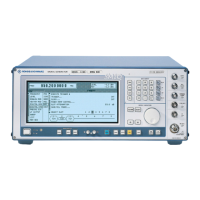SMIQ Digital Standard 3GPP W-CDMA (FDD)
1125.5555.03 E-92.231
2.14.3.5.3 Effect of SCH
The SCH is not orthogonal to the DPCHs and all other downlink channels since the synchronization
code symbol is spread according to a special scheme (see section 2.14.1.1, System Components).
In the following example, the channels P-SCH, S-SCH, CPICH, P-CCPCH and two DPCHs (15 ksps to
code 7 and 12) are included. If the SCH is compensated with the code domain power analysis, the
channel powers can be determined ideally:
Fig. 2-156 CDPA of a signal with compensated SCH
If the SCH is not compensated, crosstalk to the other channels can be clearly seen:
Fig. 2-157 Effect of SCH on CDP analysis (without compensation)
The transmitted channels are measured with an error of <0.2 dB. For all other channels a power of
approx. -40 dB is determined.
These conditions still allow error-free decoding of all transmitted channels.
2.14.3.5.4 Effect of S-CCPCH and the Other Downlink Channels
Like a DPCH, S-CCPCH, P-CPICH, S-CPICH, PDSCH, PICH, AICH and DL-DPCCH are spread with
the same symbol rate. Therefore the same conditions as for DPCHs apply to the parameters of these
channels (see section 2.14.3.5.7).
2.14.3.5.5 Effect of PRACH and PCPCH
The PRACH and the PCPCH are not orthogonal to DPCCH and DPDCHs since the scrambling code is
formed differently. Mobile stations never use PRACH or PCPCH and DPCCH/DPDCH simultaneously –
therefore mixed operation is only possible in WinIQSIM if these channel types are distributed to different
stations (e.g. MS1 and MS2).

